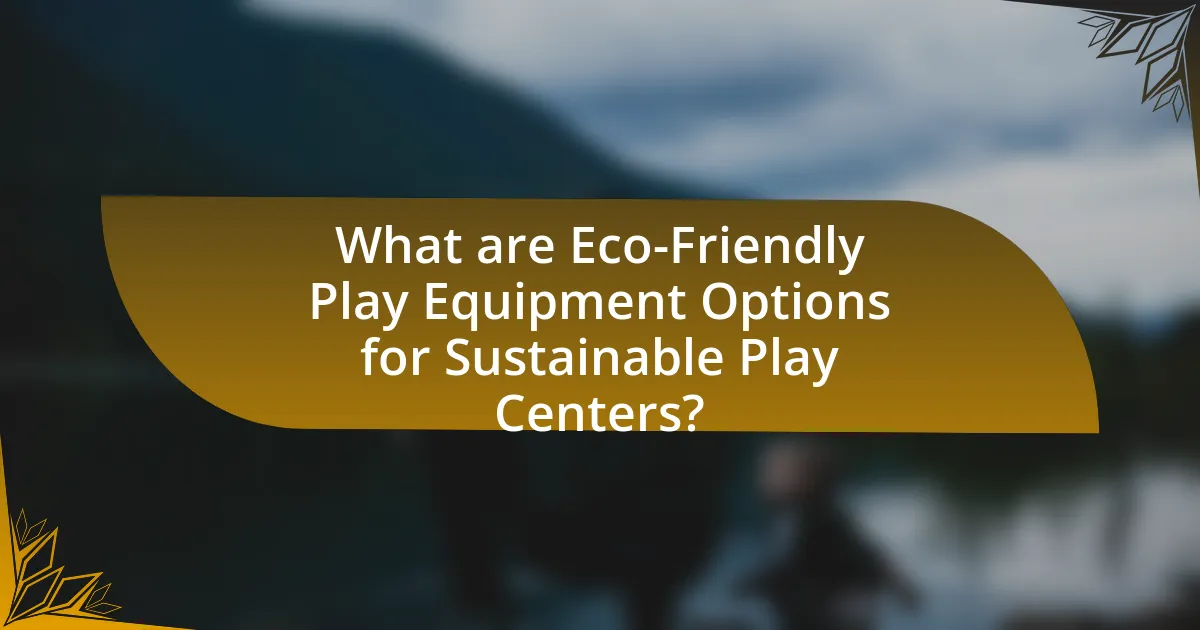Eco-friendly play equipment options for sustainable play centers include materials such as recycled plastics, sustainably sourced wood, and non-toxic finishes, which collectively reduce environmental impact and enhance safety for children. The article explores how these materials contribute to sustainability by minimizing waste, conserving resources, and promoting healthier play environments. It also discusses the benefits of natural materials in enhancing children’s play experiences, the challenges of implementing eco-friendly equipment, and strategies for selecting and maintaining such equipment effectively. Additionally, the article highlights the importance of educating staff and parents about the advantages of eco-friendly play options in fostering a sustainable future for play centers.

What are Eco-Friendly Play Equipment Options for Sustainable Play Centers?
Eco-friendly play equipment options for sustainable play centers include items made from recycled materials, natural wood, and non-toxic finishes. For instance, playground structures crafted from recycled plastic lumber reduce waste and environmental impact while providing durability. Additionally, natural wood equipment, sourced from sustainably managed forests, offers a biodegradable alternative that blends with outdoor environments. Non-toxic finishes ensure safety for children and minimize harmful chemical exposure. These options not only promote sustainability but also enhance the overall play experience by fostering a connection to nature.
How do eco-friendly play equipment options contribute to sustainability?
Eco-friendly play equipment options contribute to sustainability by utilizing renewable materials and reducing environmental impact. These options often incorporate recycled plastics, sustainably sourced wood, and non-toxic finishes, which minimize resource depletion and pollution. For instance, using recycled materials can significantly lower carbon emissions associated with production, as evidenced by a study from the Environmental Protection Agency, which states that recycling plastics can reduce greenhouse gas emissions by up to 70%. Additionally, eco-friendly equipment is designed for durability, reducing the need for frequent replacements and thereby conserving resources over time.
What materials are commonly used in eco-friendly play equipment?
Eco-friendly play equipment commonly utilizes materials such as recycled plastics, sustainably sourced wood, natural rubber, and bamboo. Recycled plastics are often derived from post-consumer waste, reducing landfill impact and conserving resources. Sustainably sourced wood comes from forests managed under strict environmental guidelines, ensuring minimal ecological disruption. Natural rubber, harvested from rubber trees, is biodegradable and provides a safe, durable surface for play. Bamboo, known for its rapid growth and renewability, is also increasingly used due to its strength and lightweight properties. These materials collectively contribute to reducing the environmental footprint of play equipment while ensuring safety and durability for children.
How does the design of eco-friendly play equipment promote sustainability?
The design of eco-friendly play equipment promotes sustainability by utilizing renewable materials and minimizing environmental impact during production. For instance, manufacturers often use recycled plastics and sustainably sourced wood, which reduces waste and conserves natural resources. Additionally, eco-friendly designs prioritize durability and longevity, decreasing the need for frequent replacements and thereby lowering overall resource consumption. Studies indicate that using such materials can significantly reduce carbon footprints associated with playground construction and maintenance, supporting a more sustainable approach to community play spaces.
Why is it important to choose eco-friendly play equipment?
Choosing eco-friendly play equipment is important because it minimizes environmental impact and promotes sustainability. Eco-friendly materials reduce pollution and resource depletion, contributing to a healthier planet. For instance, equipment made from recycled materials or sustainably sourced wood helps conserve natural resources and reduces landfill waste. Additionally, using non-toxic finishes and paints ensures the safety of children, as these products do not emit harmful chemicals. Research indicates that eco-friendly play environments can enhance children’s physical and mental well-being, fostering a connection to nature and encouraging outdoor play.
What environmental benefits are associated with eco-friendly play equipment?
Eco-friendly play equipment offers significant environmental benefits, including reduced carbon footprint and sustainable resource use. This type of equipment is often made from recycled materials or sustainably sourced wood, which minimizes waste and conserves natural resources. For instance, using recycled plastic in play structures can divert waste from landfills, while sustainably harvested wood ensures that forests are managed responsibly. Additionally, eco-friendly play equipment typically avoids harmful chemicals, contributing to healthier ecosystems and reducing pollution. Studies indicate that the use of such materials can lower greenhouse gas emissions associated with production and disposal, further supporting environmental sustainability.
How does eco-friendly play equipment impact children’s health and safety?
Eco-friendly play equipment positively impacts children’s health and safety by reducing exposure to harmful chemicals and promoting safer play environments. Materials used in eco-friendly equipment, such as recycled plastics and untreated wood, minimize the risk of injuries associated with toxic substances found in traditional play structures. For instance, studies have shown that children using equipment made from non-toxic materials experience fewer allergic reactions and skin irritations. Additionally, eco-friendly designs often incorporate rounded edges and softer surfaces, which further enhance safety during play. This combination of safer materials and thoughtful design contributes to healthier play experiences for children.

What types of eco-friendly play equipment are available?
Eco-friendly play equipment includes items made from sustainable materials such as recycled plastic, natural wood, and biodegradable components. Examples of this equipment are playground structures crafted from reclaimed wood, swings made from recycled tires, and climbing frames constructed from bamboo. These materials not only reduce environmental impact but also ensure safety and durability, as many eco-friendly products meet stringent safety standards. Additionally, the use of non-toxic finishes and paints further enhances their sustainability, making them suitable for children’s play areas.
What are the most popular categories of eco-friendly play equipment?
The most popular categories of eco-friendly play equipment include natural wood structures, recycled plastic playsets, and sustainable surfacing materials. Natural wood structures, often made from responsibly sourced timber, provide a durable and aesthetic option for playgrounds. Recycled plastic playsets utilize materials diverted from landfills, reducing environmental impact while offering longevity and safety. Sustainable surfacing materials, such as rubber made from recycled tires or organic mulch, enhance safety and accessibility while being environmentally friendly. These categories reflect a growing trend towards sustainability in play equipment, aligning with eco-conscious values in community planning and development.
How do natural materials enhance the play experience?
Natural materials enhance the play experience by providing sensory-rich environments that stimulate children’s creativity and imagination. For instance, materials like wood, stone, and sand offer varied textures, colors, and temperatures, which engage children’s senses and encourage exploratory play. Research indicates that children interacting with natural elements exhibit increased levels of creativity and problem-solving skills, as these materials promote open-ended play scenarios. A study published in the Journal of Environmental Psychology found that children playing in natural settings showed improved attention spans and reduced stress levels compared to those in artificial environments. Thus, the use of natural materials in play areas not only enriches the play experience but also supports children’s cognitive and emotional development.
What role do recycled materials play in eco-friendly play equipment?
Recycled materials are essential in the production of eco-friendly play equipment as they reduce waste and minimize the demand for new raw materials. By utilizing materials such as recycled plastics and rubber, manufacturers can create durable and safe play structures while significantly lowering their environmental impact. For instance, using recycled rubber from tires in playground surfaces can prevent millions of tires from ending up in landfills, while also providing a cushioned and safe play area for children. This practice not only promotes sustainability but also supports the circular economy by repurposing materials that would otherwise contribute to environmental degradation.
How can play centers select the right eco-friendly equipment?
Play centers can select the right eco-friendly equipment by prioritizing materials that are sustainably sourced, non-toxic, and recyclable. Research indicates that equipment made from recycled plastics or sustainably harvested wood significantly reduces environmental impact while ensuring safety for children. Additionally, certifications such as the Forest Stewardship Council (FSC) for wood products or the Green Seal for various materials can guide play centers in making informed choices. By focusing on these criteria, play centers can effectively contribute to sustainability while providing safe play environments.
What factors should be considered when choosing eco-friendly play equipment?
When choosing eco-friendly play equipment, factors such as materials, safety standards, durability, and environmental impact should be considered. Eco-friendly materials, like recycled plastics or sustainably sourced wood, minimize environmental harm. Safety standards ensure that the equipment is safe for children, while durability guarantees longevity, reducing the need for replacements. Additionally, assessing the environmental impact during production and disposal phases is crucial, as it reflects the overall sustainability of the equipment. For instance, equipment made from recycled materials can significantly reduce landfill waste and resource consumption.
How can play centers assess the sustainability of play equipment options?
Play centers can assess the sustainability of play equipment options by evaluating materials, lifecycle impacts, and certifications. They should prioritize equipment made from recycled or sustainably sourced materials, as these contribute to reduced environmental impact. Additionally, analyzing the lifecycle of the equipment, including production, transportation, usage, and disposal, helps identify potential sustainability issues. Certifications from recognized organizations, such as the Forest Stewardship Council or the Global GreenTag, provide assurance that the equipment meets specific environmental standards. This comprehensive assessment ensures that play centers select options that align with sustainability goals.

What are the challenges of implementing eco-friendly play equipment?
The challenges of implementing eco-friendly play equipment include higher initial costs, limited availability of sustainable materials, and regulatory compliance issues. Higher initial costs arise because eco-friendly materials and manufacturing processes often require more investment compared to traditional options. Limited availability of sustainable materials can hinder the selection of diverse and innovative designs, as not all manufacturers produce eco-friendly alternatives. Regulatory compliance issues may arise from local safety standards that do not yet accommodate new eco-friendly materials, complicating the approval process for installation. These factors collectively pose significant barriers to the widespread adoption of eco-friendly play equipment in sustainable play centers.
What common obstacles do play centers face when adopting eco-friendly options?
Play centers commonly face financial constraints when adopting eco-friendly options, as sustainable materials and practices often come with higher upfront costs. Additionally, there is a lack of awareness and understanding among stakeholders about the long-term benefits of eco-friendly choices, which can hinder decision-making. Furthermore, limited availability of certified eco-friendly products can restrict options for play centers, making it challenging to implement sustainable practices effectively.
How can budget constraints affect the selection of eco-friendly play equipment?
Budget constraints significantly limit the selection of eco-friendly play equipment by reducing the available options that meet both sustainability and financial criteria. When organizations or institutions face tight budgets, they often prioritize lower-cost alternatives, which may not be eco-friendly, thereby compromising environmental goals. For instance, a study by the National Association of State Boards of Education indicates that budget limitations can lead to the selection of cheaper materials that may not be sustainably sourced, ultimately affecting the overall environmental impact of play equipment.
What are the maintenance challenges associated with eco-friendly play equipment?
Eco-friendly play equipment faces several maintenance challenges, primarily due to the materials used and environmental factors. Natural materials, such as wood, are susceptible to rot, insect damage, and weathering, requiring regular inspections and treatments to ensure safety and longevity. Additionally, eco-friendly surfaces, like recycled rubber or natural grass, may need more frequent replacement or repair compared to traditional materials, as they can degrade faster under heavy use. Furthermore, the lack of standardized maintenance protocols for these innovative materials can lead to inconsistent care practices, increasing the risk of safety hazards.
How can play centers overcome these challenges?
Play centers can overcome challenges related to eco-friendly play equipment by investing in sustainable materials and innovative designs. Utilizing recycled plastics, sustainably sourced wood, and non-toxic finishes can significantly reduce environmental impact while ensuring safety and durability. Research indicates that using such materials not only minimizes waste but also promotes a healthier play environment for children. For instance, a study by the American Society for Testing and Materials highlights that eco-friendly materials can meet safety standards while being less harmful to the environment. Additionally, play centers can collaborate with manufacturers specializing in sustainable products to access the latest innovations in eco-friendly design, further enhancing their offerings and addressing sustainability challenges effectively.
What strategies can be employed to secure funding for eco-friendly equipment?
To secure funding for eco-friendly equipment, organizations can employ strategies such as applying for grants, engaging in crowdfunding, and forming partnerships with environmentally-focused businesses. Grants from government agencies and non-profit organizations specifically aimed at sustainability initiatives provide financial support for eco-friendly projects. For instance, the Environmental Protection Agency offers various grants for green projects, which can be a valuable resource. Crowdfunding platforms allow organizations to reach a wider audience and gather small contributions from many supporters, effectively raising funds for specific eco-friendly equipment. Additionally, forming partnerships with businesses that prioritize sustainability can lead to sponsorship opportunities or co-funding arrangements, leveraging shared goals for mutual benefit. These strategies are effective as they tap into existing funding sources and community support for environmentally responsible initiatives.
How can play centers educate staff and parents about the benefits of eco-friendly play equipment?
Play centers can educate staff and parents about the benefits of eco-friendly play equipment through workshops, informational sessions, and hands-on demonstrations. These educational initiatives can highlight the environmental advantages, such as reduced carbon footprints and the use of sustainable materials, which contribute to a healthier planet. For instance, studies show that eco-friendly play equipment can be made from recycled materials, reducing waste and promoting sustainability. Additionally, providing data on the safety and durability of such equipment can further reinforce its benefits, as eco-friendly options often meet or exceed safety standards while being less harmful to the environment.
What are best practices for integrating eco-friendly play equipment into play centers?
Best practices for integrating eco-friendly play equipment into play centers include selecting materials that are sustainably sourced, ensuring durability to reduce waste, and prioritizing non-toxic finishes. Using recycled materials, such as reclaimed wood or recycled plastics, minimizes environmental impact while providing safe play options. Additionally, designing equipment that encourages natural play and interaction with the environment fosters children’s connection to nature. Research indicates that eco-friendly play equipment can enhance children’s physical and cognitive development while promoting environmental awareness. For instance, a study by the University of California found that children who engage with natural play environments exhibit improved creativity and problem-solving skills.
How can play centers create a sustainable play environment?
Play centers can create a sustainable play environment by utilizing eco-friendly materials and practices in their design and operations. This includes selecting play equipment made from recycled or sustainably sourced materials, such as bamboo or recycled plastics, which reduces environmental impact. Additionally, implementing energy-efficient lighting and water-saving fixtures contributes to sustainability. Research indicates that using natural elements, like wood and stone, not only enhances the aesthetic appeal but also promotes biodiversity, as seen in studies by the University of California, which highlight the benefits of integrating nature into play spaces. By prioritizing these eco-friendly options, play centers can significantly reduce their carbon footprint and foster a healthier environment for children.
What tips can help ensure the longevity of eco-friendly play equipment?
To ensure the longevity of eco-friendly play equipment, regular maintenance is essential. This includes routine inspections for wear and tear, cleaning surfaces to prevent mold and decay, and applying protective coatings made from natural materials to enhance durability. Research indicates that equipment made from sustainably sourced wood, such as cedar or redwood, can last longer when properly maintained due to their natural resistance to rot and insects. Additionally, using biodegradable cleaning agents helps preserve the integrity of the materials while being environmentally friendly.
